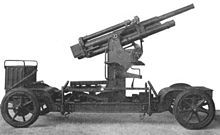3-inch gun M1917
| 3-inch Gun M1918 | |
|---|---|

3-inch M1918 on towed trailer mount
|
|
| Type | Anti-Aircraft Gun |
| Place of origin | United States |
| Service history | |
| Used by | United States Army |
| Specifications | |
| Weight | 12,200 lb (5,500 kg) |
| Barrel length | 40 calibers (120 in (305 cm)) |
|
|
|
| Shell | fixed, shell weight 15 lb (6.8 kg) |
| Caliber | 3 in (76.2 mm) |
| Elevation | +10° to +85° |
| Traverse | 360° |
| Muzzle velocity | 2,400 ft/s (730 m/s) |
| Maximum firing range | 8,600 yd (7,900 m) AA altitude |
|
|
|
|
|
|
|
|
|
|
|
|
|
|
|
|
|
|
|
|
The 3-inch M1918 gun was a United States 3-inch anti-aircraft gun that entered service in 1918 and served until it was finally superseded by the 3" M3 gun in 1930. The M3 was subsequently replaced by the M1 90mm AA gun just prior to the opening of World War II. The M3 3" gun was later adapted for the anti-tank role, serving as the main armament of the M10 tank destroyer during World War II.
The 3-inch M1917 was the United States Army's first dedicated anti-aircraft gun, entering service during World War I. Only a few were built, as the similar 3-inch M1918 on a mobile mount was considered more useful and was produced in large numbers.
Development of the M1917 started in 1915, and as the name implies, took two years to enter service. The gun was essentially an unmodified 3-inch M1903 (76.2 mm L/55) coastal-defense gun barrel on a new fixed mount allowing it to be aimed to high elevations. A number were used during World War I on fixed mountings; 116 were completed by April 1919. Most of the weapons were deployed at United States Army Coast Artillery Corps installations after World War I. In the immediate post-war era it was developed as the 3-inch M2, using a removable barrel liner. In 1928 it was further improved in the 3-inch M4 by using a thicker removable liner that eased manufacturing. However, the M2 and M4 appear to have been produced in small quantities. The M1917, M2, and M4 remained in service through World War II.
For mobile use the original coastal gun was too heavy, so a smaller version was developed as the 3-inch M1918. This weapon was based on the 3-inch gun M1898, a smaller predecessor of the M1903. This weapon had a barrel 50 calibers long instead of 55 calibers, and a smaller breech with a different cartridge (76.2x585R, 212 cubic inches instead of 76.2x690R, 293 cubic inches). The barrel of the M1918 was shortened to 40 calibers and a semi-automatic breech was added. "Semi-automatic" on this type of weapon meant that the breech would open automatically after firing. Like the adaptations that created the M2 and M4, the M1918 was also fitted with a removable liner in 1927 and a barrel 50 calibers long, becoming the 3-inch M1; a year later the M3 weapon was introduced with a larger removable liner. Another upgrade was started in 1931 as the T8, and then T9, but these projects were cancelled in 1938 when the 90 mm gun was selected in their place.
...
Wikipedia
